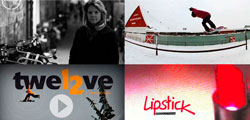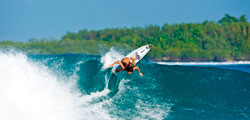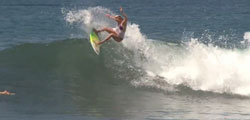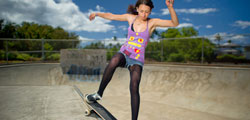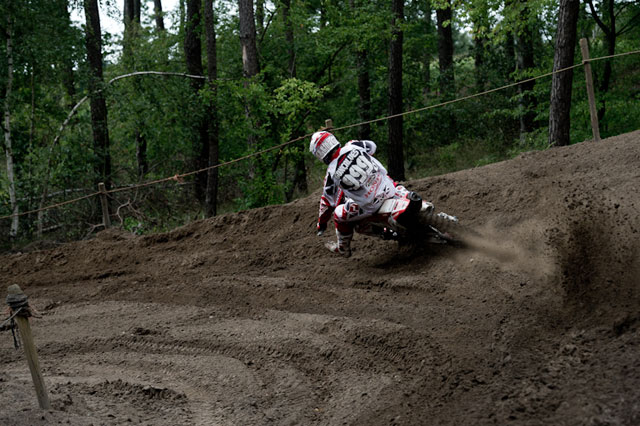
If dirty weekends with brave, buff-bodied sportsmen sound appealing then you should try out motocross! An exciting, physically demanding sport that leaves you sweaty and exhausted but infinitely exhilarated, as Polly Tracey experienced for us
What is it?
As the name suggests, motocross is motorcycle racing on off-road circuits. The design of the circuit makes it a fast-paced, adrenaline-pumping sport that makes your heart race and thighs ache. The terrain typically includes natural features such as hills and cambers, along with man-made jumps, technical corners, fast straights and rhythm sections. Referred to as MX, the sport is the motorized big brother of BMX and the racing sibling of FMX (featuring acrobatic displays judged by a panel). Motocross evolved from trials riding in the first half of the 20th century, initially known as scrambling before evolving into the sport we know today.
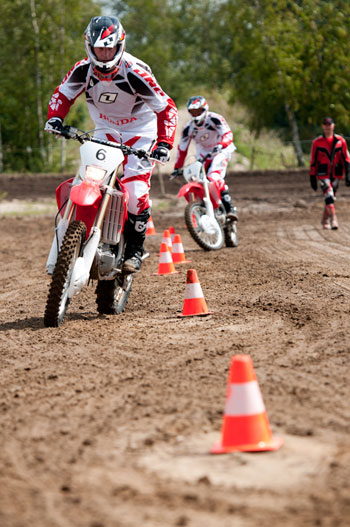
What gear do I need?
For such a physical sport it is essential to wear the correct clothing. Standard gear consists of a helmet, motorcycle boots, goggles, gloves, body armour, jersey and pants. The best deals are on full sets of kit, for example from One Industries (one of which you can win HERE!). Most MX schools can provide a helmet and boots, but it is worth investing in your own. MX is addictive so you won’t just try it once!
And what kind of bike?
You need a highly specialized off-road motorbike with long-travel suspension and knobbly tyres. One of the easiest bikes for girls to start on is the Honda CRF150RB (B stands for big wheels). It’s a 150cc four-stroke machine, with smooth power delivery (scaled down so your feet reach the ground). While being user-friendly it is a full race bike that has performed competitively throughout the world so it can be pushed as your confidence grows. Plus there is a tuning kit available as you advance. The CRF250X (an enduro bike) or 250R is suitable if you’re a bigger-framed lass.
In the World Championships the classes are governed by engine sizes: MX1 up to 450cc, MX2 up to 250cc, MX3 is open. My expert instructors – Honda World Motocross Riders Evgeny Bobryshev and Rui Gonçalves – both ride a race-modified Honda CRF450R.
Where can you try it?
You can get started with an MX Experience Track Day at Silverstone for £199 pp including all protective clothing and equipment, the use of a range of Honda bikes, full off-road tuition catered to your ability and lunch. Go to www.mickextanceoffroad.com
Belgium is the centre of the MX World where most of the pro riders live and train, making use of the many practice venues. Circuits cost from as little as £15 per hour (hondapark.be). Brits can easily drive from Calais (3 hours) and pair it with a hotel in Antwerp for a perfect active/shopping/city break – for all Euro mainlanders the travelling is just as easy.
Getting started
Seasoned motorbike road-riders benefit from established techniques such as clutch control, meaning they can quickly advance to handling exercises. Getting used to the clutch and gear changes can be tough for absolute beginners. It is important to ease the clutch off slowly and smoothly to start with and build up to tackling technical demands such as rhythm sections.
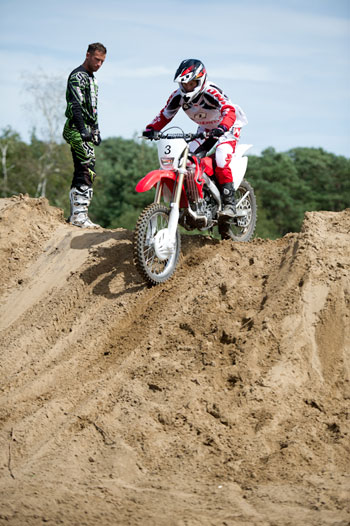
Fitness
You need to have a good level of fitness to get the most out of motocross. It really works out the inner thighs so a conditioning routine including squats is good preparation. It is also mentally challenging, as you constantly have to adjust to the terrain – professional riders can maintain an intense level of concentration and race at full-speed for 40-minute durations. Beginners should start with short sessions of around 10-minutes. An hour riding can burn up to 800 calories. Drinking plenty of water is imperative.
Stance
The key to riding motocross is to maintain a dynamic stance – flexibility in the knees and strong grip with the thighs. Flexed knees allow the body to absorb the lumps and bumps on the track and cushion landings from jumps.
Learning to turn
On the approach to a turn, you reduce speed and put out your inside leg, keeping it suspended above the ground. This is your security blanket in case you need to adjust your balance and touch the ground, so it is essential to keep it high and forward to prevent injury.
Bumps and jumps
It doesn’t take long to progress to small jumps. It is important to retain a firm but relaxed upper body frame, centralize your weight on take-off and in the air and to spot your landing early. Advanced techniques include mid-air adjustments of the ‘bike – using the throttle and back brake to bring the front up or down as required.
Tricks
MX is a racing sport rather than an acrobatic display sport so enhancing speed is the main objective. The best tricks are the ability to take corners eye-wateringly tight, to get a speedy start away from the pack, to ride bumps smoothly and to land double, triple or even quad jumps (where you take off from the first one, clear the middle section and land on the down-side of the last one). There is no shortage of excitement watching a pro testing on a circuit and you may catch them doing ‘big whips’ or ‘scrubbing’ over jumps to gain more forward momentum.
Where can you watch?
MX races are visually spectacular with an intense starting line-up of up to 40 riders. Position in the line is dependent on qualifying races and can be critical to success. World Championship motocross is governed by the FIM (The International Motorcycling Federation) and at the highest-level riders compete in the World Championships in MX1, MX2, MX3 or WMX (women’s). You can buy entrance tickets for any of the events, which draw crowds of up to 40,000 people. Go to motocrossmx1.com for more information.
Polly Tracey learnt to MX with the Honda World Motocross Team Riders Evgeny Bobryshev and Rui Gonçalves and Honda Xtreme Academy Coach Brian Jorgensen. Find out more about the riders and what they are up to at hondaproracing.com
Win yourself some kit from One Industries in our fabulous comp!

